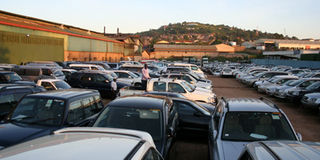What ban of cars older than 8 years means

Most car bonds in Uganda will be affected should the Bill become law. File Photo
What you need to know:
Government has finalised drafting a Bill that seeks to ban importation of all vehicles that are older than eight years from the date of manufacture. Mustafa Ziraba discusses its implications on buyers and importers.
The Traffic and Road Safety Amendment Bill 2018 which will be tabled by Ministry of Finance, is premised on government’s intention to protect the environment from dangerous emissions and to encourage the development of a local automotive industry. However, motor vehicle importers have said the Bill was rushed and it will make buying cars practically impossible for all but the rich. What does this mean for current drivers and future drivers?
More improvements
Newer cars are built predominantly for markets where legislation prescribes what safety features they must have and where vehicle testing and grading is robust, for example The European New Car Assessment Programme. Despite the basic concept remaining relatively unchanged, modern cars have undergone a series of many little successive improvements to make them different from their yester-years predecessors.
Fuel efficiency
The basic principles of the very first cars are still used today. One of the main differences is that modern cars are the result of pressure to improve the power of engines and ultimately fuel efficiency and reduce emissions. In part, this has been due to market pressure from owner demand but is most largely from governmental legislation and environmental control initiatives.
Good engines
Starting with efficiency, burning fuel, like petrol, is not particularly efficient. Of all the potential chemical energy in it, around less than 40 per cent is converted into energy that actually moves the car. The rest is lost to idling, parasitic losses, friction all which ultimately produce the greatest loss of all, heat. But newer cars have engines that have moved a long way to yield as much energy as possible from the fuel. Direct injection technology, for example, does not pre-mix the fuel and air before reaching the cylinder as is the case in older engines. Rather, fuel is directly injected into the cylinders.
Turbochargers use exhaust gas to power a turbine that pushes extra air (meaning more oxygen) into the cylinders to further increase efficiency. Variable valve timing and cylinder deactivation further improve efficiency by only allowing the engine to use as much fuel as it actually needs. Other technologies used for emission control include use of ad blue and diesel particulate filtration systems for the diesel engines. So all those acronyms you see on your car such as D4 and VVTi, are not just for marketing.
These technologies too have enabled manufacturers to meet the emissions requirements of the markets in which they are selling their cars. It is this very premise that NEMA and the policy proponents are using to push through the ban. While true, that a newer car simply based on elementary logic shall have less emissions than an older car, the technology that curbs emissions in cars has not drastically changed with the fundamentals such as how catalytic converters work for a 2005, 2012 or 2018 model year car remaining exactly the same.
Withstanding conditions
What actually makes the older cars to fail emissions is secondary elements such as poor maintenance routines, use of adulterated fuel, bad oils, and simply continued bad driving habits including but not limited to unnecessary acceleration. Which this in mind, a well-maintained 2005 Premio having better emissions than a 2016 Premio is a real possibility.
Enter SGS. These are the people mandated to do as part of their annual tests an emissions check. Maybe we have a guideline that all cars newer than eight years are exempt from emissions test but those older should be tested annually and penalties implemented as the authorities see fit. And before cars older than eight years are allowed into the country, a bilateral agreement with the source countries to vigorously test the car and certify it.
Cost
It is evident that newer cars are more expensive than what a typical Ugandan car buyer is used to. A simple search online for one of the most popular cars today, the second generation Toyota Harrier also known as the Kawundo tells you that the cheapest 2003 model from Japan is about USD 4,000 (about Shs14.7m). The 2011 model year of the same car that fits within the proposed policy prescription is averaging USD 12,000 (about Shs44.3m).




